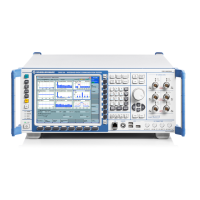Basic Instrument Functions
R&S
®
CMW500
94User Manual 1173.9463.02 ─ 06
Detailed Test
Detailed tests are board-specific tests that cannot be grouped into one of the previous
categories. In general, detailed tests are intended to be performed by R&S service rep-
resentatives.
4.4.5.3 Unit Tests
A unit test verifies that the communication between several internal modules of the
instrument is uninterrupted. A passed unit test usually proves that several modules (e.g.
boards and bus systems connecting these boards) work properly.
Unit tests and board tests
A unit test represents an efficient method for testing the instrument's overall functioning.
After a failed unit test, you can use one of the module tests to pin down the source of the
malfunction. Some examples of unit tests are described below.
RF Loop Test
A signal which is generated on one of the installed TRX modules is routed to a frontend
connector RF <n> COM and back to the TRX module. The main purpose of the test is to
verify the connections between the TRX module and the frontend. The RF loop is mea-
sured at different frequencies and TX levels using an additional BB measurement module.
The header row of the overall loop test shows the output levels in dBm at the RF <n>
COM connectors. The actual levels measured are approx. 6 dB above the equivalent RF
<n> COM levels.
Sample Bus Test
A pseudo-random bit sequence (PRBS) is transferred over the sample bus between two
hardware modules. The R&S CMW500 compares the transmitted PRBS with the received
PRBS and verifies that no bit errors occur in the transmission path.
External Tests
One or more R&S CMW500 connectors are tested using external cable connections.
External tests require the "User (Extended)" mode; see "User Mode" on page 86.
Setup Dialog

